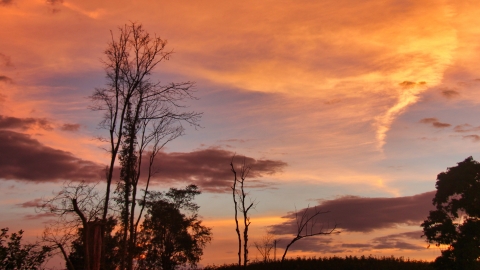From restaurant to a king's resting place
Few people know that, before becoming a villa named after the last king, this place used to be a restaurant called Maison Lefévre (before 1905). In 1914, the location was chosen to build the District Chief's Office under the time of Consul Sabatier, then continued to be renovated by Consul Giran in 1926, becoming the consulate that the locals called Sang Ae Prong (Big Man's House).


Bao Dai Palace seen from the grounds of Dak Lak Museum
In 1947, when the French brought Bao Dai back to Vietnam as Head of State, he chose Buon Ma Thuot as his resting place. From November 1947 to May 1948, the king stayed and worked in this building for nearly 8 months. Later, he often returned at the beginning of the rainy season to rest and go hunting. From these marks, the building was called Bao Dai Palace - one of the palaces that this king owned throughout the country.
Harmonious architecture, cool green space
Spread over an area of nearly 6.5 hectares, the villa complex consists of a main building and an elephant trainer's house, built on an artificial mound nearly 2 meters higher than the yard. Seen from afar, the gentle steps leading to the villa seem to lift visitors' steps, evoking a feeling of comfort in the middle of the mountains and forests.


The unique point of the project lies in the combination of traditional Central Highlands architecture with the rusticity of the Ede long house and the sophistication of European style. With a construction area of 1,514m2, the villa both exudes the classic beauty of the mountains and forests, while maintaining the luxury of royalty.

The villa was built in the architectural style of the Ede long house.
Royal touch in every room
Stepping through each room, visitors can feel the breath of a golden age still lingering. Many spaces remain almost intact with items associated with the life of the last king. On the large bed covered with exquisite bedding, each seam and pattern is reminiscent of the sophistication and luxury of the royal court.


The king's bedroom in the palace
In the living room, two portraits of King Bao Dai and Queen Nam Phuong are hung solemnly along with many precious souvenirs such as military books, national flags of various countries or photos of the return of the gold medal. The wooden chairs are meticulously carved, decorated with ivory patterns, creating a noble look but still in harmony with the mountains and forests of the Central Highlands.



Living room space in the villa with two portraits of King Bao Dai and Queen Nam Phuong
On the walls, deer heads, hunting rifles and photos of trophies are hung solemnly, proving King Bao Dai's pleasure of hunting. Next to them are tea sets made of gold and ivory-glazed porcelain with delicate patterns, which were used in important receptions.



In particular, in that space, one can also see the blending with indigenous culture: a simple rattan basket leaning against the corner of the house, a set of elegant rattan chairs or a few familiar objects of the Central Highlands people, all creating a unique blend between royalty and rustic life.


The kitchen in the villa with familiar utensils of the Central Highlands people
Those small details make visitors feel like they are entering a vivid historical story, where the royal mark and the breath of the wild blend together.
Heritage camphor trees and green lungs in the middle of the city
Not only is it a historical structure, the villa also stands out for its diverse ecosystem. In the shady area, there are many ancient trees hundreds of years old such as camphor, purple-flowered lagerstroemia, and ca chit. A special highlight is the camphor tree right at the entrance, planted in 1930, nearly 30 meters high, with a trunk 2.5 meters wide. In 2014, the tree was recognized as a Vietnamese Heritage Tree, becoming a favorite stop for many domestic and foreign tourists.


The villa is surrounded by green grounds with many-year-old camphor trees.
With its rich flora, the villa is like a “green lung” in the heart of Buon Ma Thuot, where visitors can temporarily escape the hustle and bustle of the city to immerse themselves in a cool, tranquil space.
From historical sites to cultural attractions
Today, Bao Dai Palace has been recognized as a national historical site and has become a must-see attraction when coming to Buon Ma Thuot. The leaders of Dak Lak Museum are also implementing a restoration plan, aiming to open to welcome visitors with a more complete appearance, combining exhibitions with the special national relic Buon Ma Thuot Prison and museum spaces, forming a closed tour route for visitors to both explore history and learn about the people and nature of Dak Lak.

Bao Dai Palace in Buon Ma Thuot is little known but is a place that possesses both landscape and cultural and historical values of the Central Highlands.

Stopping at Bao Dai Palace, visitors not only discover the place where a king once left his footprints, but also immerse themselves in the interweaving picture of culture, history and nature of the Central Highlands. This is the destination that preserves the breath of a historical period and is still being preserved, to tell the next generation the story of the last king of the Nguyen Dynasty in the great forest of Buon Ma Thuot.

 EN
EN


































